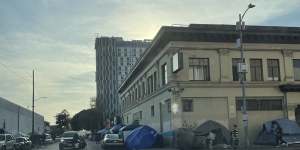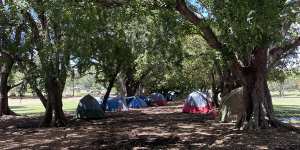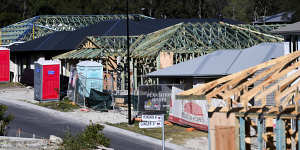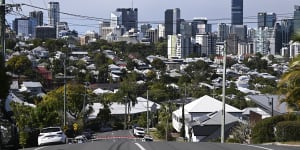Down some footpaths,tents stretch as far as the eye can see.

Some estimates put Skid Row’s homeless population at 5000.Courtney Kruk
Skid Row has been part of the city’s fabric since the late 19th century. Despite promises over the years,the neighbourhood has never been more crowded,amid LA’s housing crisis,economic pressures,and the opioid epidemic.
The cause is understandable,but the dissonance is hard to reconcile.
California is one of the richest states in America. Skid Row is only a few blocks from LA’s financial district,five-star hotels and luxury apartments. The glamour and exceptionalism of Hollywood hangs in the distance. In four years’ time,the city will host the Summer Olympics. What will that mean for LA’s homeless population?
The scale and cultural climate is different,but a taste of that disparity is growing in Brisbane.
In parks,under bridges and along the riverfront,an increasing number of tent clusters have started to appear.
It’s indicative of the greatest challenge facing Brisbane right now:housing and homelessness.
In Queensland,homelessness has risen by 22 per cent since 2017 (compared to 8 per cent across Australia). The latest census data found approximately 10,000 people in south-east Queensland were homeless on any given night,with an increasing number of families,single and older women,and children at risk.
Urban planner and strategic land-use expert Dr Mark Limb says the visibility of homelessness in and around Brisbane is only the tip of the real problem.
“There’s a whole range of people you never see sleeping rough all over the place,” he says.
“To me,it shows a systemic failure,and it fits into a growing trend of increasing inequality as well ... It’s quite distressing.”
Michael Fotheringham,the managing director of the Australian Housing and Urban Research Institute,says the city’s current housing crisis has been 30 years in the making. “Frankly,we spent too many years sleepwalking our way into it.”
The pandemic hastened the tipping point. In the five years before the,Queensland recorded the largest number of interstate arrivals.

Tents in South Brisbane’s Musgrave Park a few kilometres from the city’s CBD.Courtney Kruk
During COVID,Brisbane experienced,which led to more demand for rental properties. Projections now estimate an,with almost 500,000 to move to the Brisbane City Council area alone.
The city’s rapid growth has far outpaced housing supply,a fact worsened by inflation,construction shortages,low vacancy rates and the cost of living crisis.
,Brisbane apartment rents have risen by 23 per cent,and house rents by 33 per cent.,59 per cent are facing unaffordable housing costs,and 15 per cent are suffering severe housing affordability stress.
But University of Queensland demographer Dr Elin Charles-Edwards says solving the housing crisis is not just about building more houses.
“There’s also the complexity that we’re not only building the supply up,we’re building the right type of housing in the right places,” she says.
Governments make decisions about future housing partly based on demographic data and migration trends,but Charles-Edwards says these models became somewhat redundant during the pandemic. This has made facilitating the right kind of housing difficult.

The city’s rapid growth has far outpaced housing supply,a fact worsened by inflation,construction shortages,low vacancy rates and the cost of living crisis.Dan Peled
But other indicators can be used.
“Household composition has changed over time,and with an ageing population,we’re seeing a decline in the average household size,which is actually increasing further aggregate demand for housing,” she says.
“We need to build more housing at the right price point,but also in locations where people can access employment,transport and their social networks as well.”
There’s a tension point unique to south-east Queensland in this argument:compared to Sydney and Melbourne,has,historically,been tied to single-dwellings on larger blocks with backyards,a character trait we’ve been reluctant to relinquish.
There is a real fear of mixed and higher-density residences,but experts are unanimous that they are needed to counter the rise in single-person households,to capitalise on existing infrastructure,and to use space efficiently.
“We need a diversity of dwellings in every neighbourhood,” Fotheringham says.
“It’s not just about building high-rises in the city and in urban-sprawl suburbs,it’s about having that mixture in every location so we have opportunities for people to find the right size in their community.
“We really need to encourage the development of more townhouses,more three- to four-storey apartment complexes that don’t change the amenity of the suburbs or the characteristics of a neighbourhood.”
More social and affordable housing is also desperately needed.
Social housing is less than 4 per cent of the entire housing market in Queensland,which has steadily declined over the past decade. Presently,almost 150,000 households across the state have unmet housing needs,100,000 of which would typically be eligible for social housing.

“We need a substantial amount of social housing. That’s the house we can triage to those most in need first then,hopefully,build it up as well so other people can have affordable housing,” Limb says.
There are indications the Queensland government understands the urgency. The recently announced Homes for Queenslanders plan included a $1.25 billion investment in more social housing and support for low-income renters.
According to Limb,the increasing politicisation of the issue is a good thing.
“It’s really starting to shift to middle-class people. Now we’re starting to see young people from middle-class families who don’t see hope in the world because they can’t have a place of their own. That’s the dream that has been held out to them.
“The more that affordable housing becomes a political issue,the more politicians in a democracy will eventually turn to and start to resolve it. I think we’re seeing that already.”

UQ demographer Dr Elin Charles-Edwards says we need to build more housing at the right price point in locations where people can access employment,transport and social networks.Dan Peled
Fotheringham works with all state and federal governments and says the Queensland government is focused on resolving the housing crisis. But there might still be a few rough years ahead.
“It’s not something we can just fix. All three levels of government have to jump in,as does the community sector,as does the private sector.”
Los Angeles Mayor Karen Bass won the election in 2022 largely based on her ambitions to find solutions for the city’s growing homeless population.
Late last year,she told reporters:“We’ve been building the plane while flying it. This is about inventing something out of air because a system to prevent people from being homeless … has not existed before.”
There’s a sense that Brisbane is in a similar predicament. The city is scrambling for solutions while the issue continues to snowball.
Stopping that momentum is not easy,and it might require some big thinking for a city that is still coming around to the idea that it isbig.
This article was produced in collaboration with the Australian Science Media Centre,with support from the Walkley Foundation-administered Meta Public Interest Journalism Fund.
Get the inside word on the news,sport,food,people and places Brisbane is talking about..